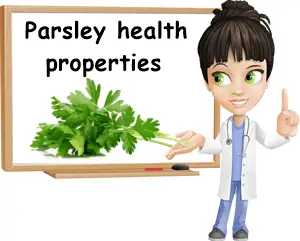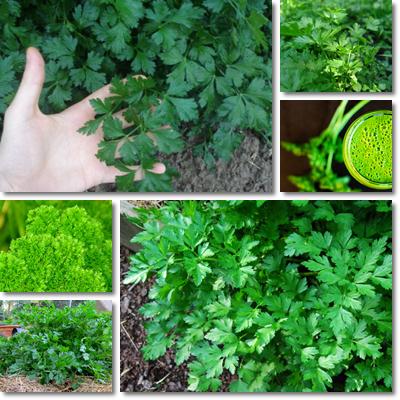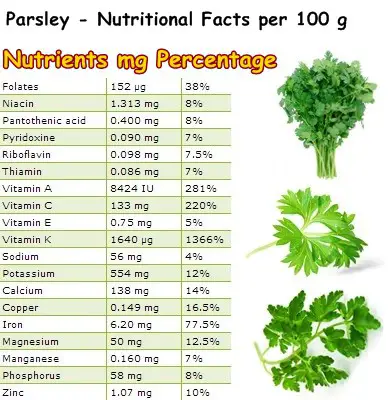Highly nutritious and full of flavor, parsley (Petroselinum crispum) is a favorite in numerous Asian and European cuisines. Although nowadays it is widely cultivated throughout the world, it is actually of Mediterranean origin.
Parsley is widely used in numerous cuisines in a great variety of dishes and highly appreciated for both its savor and its curative properties derived from its incredible content of vitamins A, C, K, B9 and iron. Both the fresh leaves and young stems are used as seasoning or garnish and boast medicinal properties.
Parsley is not only a savory herb, but also a potent medicinal plant. Parsley has no cholesterol and, in addition to this, it is rich in antioxidants, vitamins and dietary minerals. Vitamin A, beta-carotene, vitamin C and lutein are among the most potent antioxidants in parsley, capable of reducing oxidative stress caused by free radicals and reversing cell and DNA damage.
Vitamin A is also the precursory of perfect vision and beautiful skin, vitamin C a powerful anti-inflammatory, while lutein helps prevent age-related macular degeneration.

Parsley is a great source of vitamin K, which is known to play an essential role in bone health and blood coagulation. Parsley may actually be the richest source of vitamin K found in nature. However, because vitamin K is a fat-soluble nutrient, you need fats to be able to absorb it.
So if you are eating parsley for its vitamin K content, make sure you eat it with some healthy fats such as olive oil, salmon, tuna, eggs or dairy. Also, because vitamin K helps blood coagulate, you should talk to your doctor first about how much parsley and other sources of the vitamin you can eat if you are predisposed to blood clots or are on anticoagulant medication.
Parsley contains vitamins B1, B2, B3, B5 and B6, with higher concentrations being observed in the older, more mature and dark-colored leaves. As far as minerals are concerned, parsley is definitely a good source of calcium, potassium, magnesium, manganese and iron. Potassium, for example, helps regulate heart rate and blood pressure and is highly efficient in neutralizing the harmful effects of sodium.
A good intake of potassium helps with extrasystoles, palpitations and other types of arrhythmia.
Manganese is a co-factor for the manganese superoxide dismutase enzyme, an enzyme with potent antioxidant effects that is said to offer strong UV protection. Iron is essential for the production of red blood cells and vital for managing anemia. However, the iron in parsley is different from the iron in meat products in the sense that it might be more poorly absorbed. In order to maximize iron absorption from vegetable sources you need generous amounts of vitamin C which, fortunately, parsley also contains.

Parsley is also a good source of dietary fiber, indigestible plant material that is not absorbed during digestion. Dietary fiber helps reduce cholesterol levels by binding to fats in the gut, indirectly reducing absorption. Its beneficial effects on the digestive system contribute to relieving constipation as a result of regulating digestion and improving transit time, with further benefits for hemorrhoids sufferers.
Although parsley provides only 3.3 g of dietary fiber/100 g and you don’t eat much of it anyway, its contribution remains minimal, but still important for digestive health. Because fiber reduces the time your colon is exposed to water by regulating bowel movements and balances intestinal pH, it helps protect against free radicals and reduce the risk of colon cancer.
In addition to this, parsley contains volatile essential oils such as myristicim, limonene and eugenol. The latter, eugenol, has been used in dentistry as a local anesthetic and antiseptic. These essential oils, although present in small amounts, give parsley its unique taste and smell and exert potent natural antibacterial, antifungal and antioxidant effects. Other herbs also rely on essential oils to provide them with their unique flavor and health benefits.

Lastly, parsley is such a rich source of antioxidants that it is recognized as one of the best antioxidant food sources in the plant world. The herb is also quite versatile in the kitchen. It is used as garnish to potato dishes, rice, fish, steaks and stews or as an ingredient in soups and stocks. It is also a main ingredient salads and sandwiches and a topping for various soups and salads. All in all, it would be a wonderful idea to add some freshly chopped parsley to any dish you feel needs a bit of crunch and flavor. Not only will it taste better, but it will also make it healthier.
About growing parsley
If you are thinking of growing your own parsley, you will be surprised to learn how easy it is. Just find a patch of garden space and plant the seeds; you can simply throw them on the ground, then cover with a light layer of soil. Water them until they grow big and beautiful and you can start eating – that’s basically it. To avoid leaves yellowing and losing flavor, parsley is best planted in a slightly shaded garden area, not in direct sun. And know that it will take some time for the seeds to germinate (14-20 days, depending on factors such as temperature, soil conditions), so you’ll need to be patient. You can enjoy the leaves fresh and tender or let them mature until they turn a darker green and acquire more flavor. The older leaves have the benefit of concentrating more nutrients.
Depending on the variety, parsley may take on a more or less intense green color; also, the leaves can be straight or curly. You can examine the images above in order to see how different varieties may turn out. All things considered, it is a savory and extremely nutritious herb, as well as a wonderful medicinal plant, highly recommended for consumption. Its nutritional value is superior to many other spices and herbs, but nevertheless a source of many health benefits.
